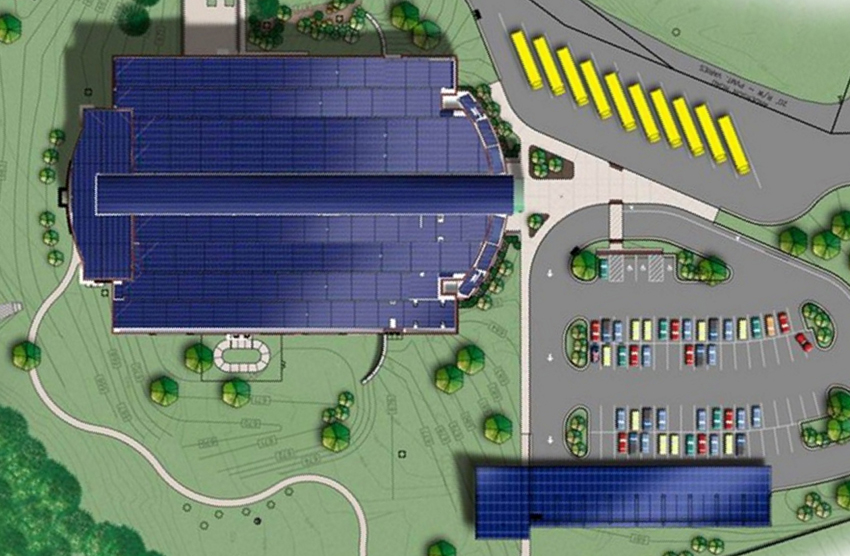Zero-Energy Schools: How Innovative Concrete Systems are Making It Possible
Zero-Energy Strategies
“The key to achieving zero energy is drastic energy reduction and cost shifting to areas that pay dividends. It starts with efficient floor plans that are fully optimized (high net-to-gross ratio) and less expensive to construct,” explains Ben Robertson, an engineer with CMTA Inc. “Sure, any building can be zero energy—but doing it without spending more money is where true success is achieved.”
Although installing on-site renewable energy infrastructure such as solar arrays is coming down in price, it still requires an up-front investment. Making the building as energy efficient as possible helps to reduce the size of the renewable power infrastructure needed, thus keeping initial costs down. In addition, using cost-effective construction methods and materials allows room in the budget for the initial investment in power-generating equipment. The following are the key strategies to achieving these goals.
Passive Solar Strategies
Building orientation, daylighting, building volume, and thermal mass are all building properties that can be optimized by designers to help reduce energy consumption without increasing cost or compromising function and aesthetics. Passive solar strategies include:
- East/west building orientation: If possible, line up the building’s main circulation axis in an east/west orientation with academic spaces along the north and south walls of the building to control natural light.
- Daylighting: Use daylighting for classrooms with a combination of exterior solar shades to block sun during high sun orientation or light shelves to reflect light deep into interior spaces during low-sunlight conditions. Use clerestories or windows mounted at higher elevations with ceilings sloped to the interior to allow light to penetrate further. Use aerogel insulated glazing or low-e coatings to reduce solar heat gain.
- Compact building volume: Use rectangular, multistory designs (at least two stories) to reduce the exterior wall-to-floor area, window-to-floor area, and roof-to-floor area ratios.
- Thermal mass: Use building systems that have high thermal mass, such as concrete, for the walls and floors of the structure.
High-Performance Envelope and Structure
Sherman Carter Barnhart, along with other architects highlighted in the case studies below, have come to the realization that ICFs incorporate all of the properties needed for zero-energy school construction. ICFs are used for the following reasons:
- They act as load-bearing walls with super insulation, thermal mass, and air barrier all in one. ICFs create one of the tightest envelopes available. Low air-infiltration rates can be achieved with other systems, but it is significantly more complex.
- They reduce sound transmission from outside and between classrooms, as well as for gymnasiums, music rooms, and theaters.
- They keep students and teachers safe from Mother Nature’s wrath. Concrete systems are resistant to fire, tornados, hurricanes, floods, and earthquakes.
Energy-Efficient HVAC Systems and Technology
The use of energy-efficient mechanical systems and active-control technology is critical to keeping EUI as low as possible. Strategies include:
- Use efficient geothermal HVAC systems with variable-speed heat pumps. Use one heat pump for two classrooms.
- Use occupancy sensors for lighting and other occupancy dependent systems.
- Control outside air ventilation with dedicated outside air systems, heat-recovery wheels, and demand-control ventilation based on occupancy.
- Use automated dimming to reduce artificial lighting requirements. Although if using LED lighting, automated dimming can be eliminated since LED lighting is extremely energy efficient.
- Use ENERGY STAR convection ovens as a healthier option to traditional fryers and skillets, which eliminate the need for energy-intensive Type I ventilation hoods.
- Use ENERGY STAR laptops on carts that permit computers to be transported to classrooms instead of having dedicated computer labs with energy-intensive desktops.
- Use dark-sky approach to exterior lighting. Use security lighting with motion sensors to alert local police if there is activity on school property after dark.
On-site Power Generation
Most schools, including Richardsville Elementary, use photovoltaic panels as the main source of on-site power generation. Solar panels are becoming more common at schools across the United States. According to the Solar Energy Industries Association report titled “Brighter Future: A Study on Solar in U.S. Schools,” there are approximately 5,500 K–12 schools with solar photovoltaic installations in the country. A precipitous decline in the cost of solar panels has made installations financially viable. According to National Renewable Energy Laboratory, the cost of commercial solar installations has fallen to $2.80 per watt in 2017 compared to $7.24 per watt in 2010, a 60 percent decline in just seven years. This explains why 61 percent of the solar capacity in K–12 schools has been installed in the past five years.
With that said, there is still a capital cost of solar-panel installation that must be accounted for to meet the strict budget limitations of most school boards. The following are key strategies:
- Minimize the EUI of the building using all of the strategies previously mentioned. According to the New Building Institute, the target EUI for zero-energy schools is 20–24 kBtu/ft2 or lower if possible.
- During construction, utilize design strategies and building systems that are efficient and cost-effective to help offset the initial cost of solar panel installation.

Image courtesy of Sherman Carter Barnhart Architects and CMTA Inc.
East/west orientations, daylighting, and compact volume all helped to reduce the energy consumption of Richardsville Elementary School.









